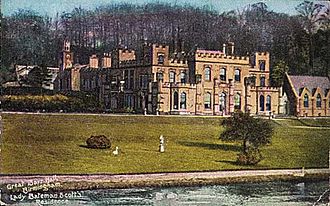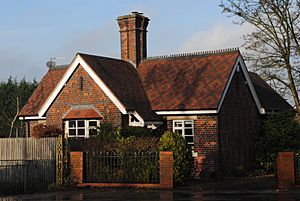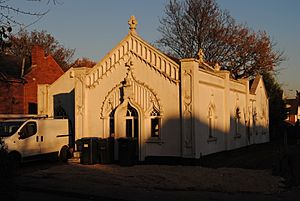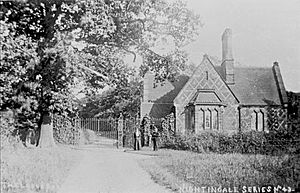Great Barr Hall facts for kids
Quick facts for kids Great Barr Hall |
|
|---|---|

1907 postcard
|
|
| General information | |
| Status | Derelict, at risk |
| Type | Mansion |
| Architectural style | Strawberry Hill gothic |
| Town or city | Pheasey, Walsall |
| Country | England |
| Coordinates | 52°33′23″N 1°55′15″W / 52.556283°N 1.920961°W |
| Construction started | 18th century |
| Client | Joseph Scott |
| Owner | Local consortium |
| Designations | Grade II listed |
Great Barr Hall is an old mansion from the 1700s. It's located in Pheasey, Walsall, near Birmingham, England. This grand building has a special history, including links to a famous group called the Lunar Society. It's also a Grade II listed building, which means it's important and protected. Sadly, it's currently in very bad condition and is on a list of buildings that are 'at risk' of being lost forever.
Contents
History of Great Barr Hall
The Scott Family and the Lunar Society
Around the mid-1600s, a man named Richard Scott bought the house that was already on this land. It was called Nether House back then.
Later, around 1777, Joseph Scott (who later became Sir Joseph Scott) built a brand new mansion. This new house was designed in a special style called Gothic Revival, which looks a bit like old castles. The house was made bigger and changed in 1840 and 1863. A chapel was also built next to it, probably designed by a famous architect named George Gilbert Scott.
Outside the chapel, you can find the burial spots for some of Lady Bateman Scott's pets. She even wrote poems for them, which are carved into their tombstones!
The Scott family faced money problems, so they rented out the hall from about 1788. A man named Samuel Galton leased it. For some years, Great Barr Hall became a meeting place for the Lunar Society. This was a very important group of thinkers and scientists who met during the Enlightenment. They discussed new ideas about science, industry, and art. People say it was their "favourite place to meet."
In 1791, Sir Francis Scott, a relative of Joseph Scott, inherited the land. He was able to move back into the hall when the lease ended. He lived there until he died in 1863. His wife, Mildred, continued to live in the hall until her death in 1909.
What Happened Next?
In 1911, a local hospital group bought the estate. By 1918, it became St Margaret's Mental Hospital. Many new hospital buildings were built around the hall.
In the 1980s, the grounds around the hall became a nature reserve. This reserve is looked after by the Staffordshire Nature Conservation Trust. However, the hall itself was left empty in 1978. Even though it was listed as a Grade II* building in 1971 (meaning it's very important), it was allowed to fall apart.
The hospital started to close down in stages from the late 1980s. The last patients left a newer part of the site in 2004. A special school called The Queslett School, which was also on the grounds, closed in 1988.
For many years, people talked about protecting the hall, but nothing happened. In 2006, a company called Bovis Homes bought the large estate. They got permission to build new houses there. A new housing area called Nether Hall Park was finished in the 2010s.
In May 2011, the hall, which was still in ruins, was put up for sale for £2.2 million. A group called the Manor Building Preservation Trust had bought it earlier but failed to make it safe. It didn't sell at that price. So, in February 2012, it was put up for auction with a lower starting price. It still didn't sell.
Finally, in May 2012, a group of ten local people bought it. They have hired architects to talk to the public and explore new ways to use the hall. Great Barr Hall is still on English Heritage's "Buildings at Risk Register," meaning it needs urgent help to be saved.
Lodges of Great Barr Hall
The Hall used to have six lodges, which are like small gatehouses at the entrances to the estate. Three of them are still standing today:
- Avenue Lodge, located on Chapel Lane (52°33′38″N 1°55′50″W / 52.560556°N 1.930551°W)
- Handsworth Lodge, found where Handsworth Drive meets Queslett Road (52°32′47″N 1°55′29″W / 52.546292°N 1.9246486°W)
- Walsall Lodge (also known as Merrions Wood Lodge), on Birmingham Road. This one was designed by George Gilbert Scott in 1858 (52°33′44″N 1°56′37″W / 52.5623476°N 1.9436356°W)
Sadly, three other lodges are now gone:
- Beacon Lodge, on Beacon Road (approx. 52°33′30″N 1°54′42″W / 52.5583335°N 1.9117714°W)
- Church Lodge, across Chapel Lane from Avenue Lodge (approx. 52°33′38″N 1°55′48″W / 52.560474°N 1.930024°W)
- Queslett Lodge, near where Queslett Road meets Beacon Road (approx. 52°33′11″N 1°54′35″W / 52.5530792°N 1.9098169°W)
Lakes of Great Barr Hall
In the grounds of the hall, there are two large, man-made lakes. They are called Great Barr Hall Upper Lake and Great Barr Hall Lower Lake. The lakes are on two different levels, with a small waterfall between them. You can cross this waterfall using stepping stones.
The upper lake gets its water from a stream called the Holbrook. Water flows out of the lower lake at its southern end. This water then travels through Perry Reservoir and eventually reaches the River Tame. From there, the water flows into the Trent, then into the Humber, and finally out to the North Sea.




